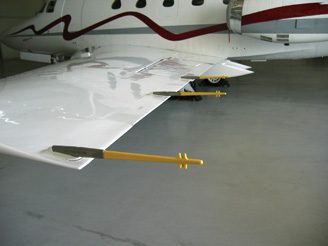The 75 Years of Innovation series highlights the groundbreaking innovations spanning from SRI’s founding in 1946 to today. Each week, SRI will release an innovation, leading up to its 75th anniversary in November 2021.

First commercial electrostatic discharge rod to protect airplane wings from radio interference and static electricity
A shocking development: How an SRI invention protected air flight from static electrical damage
Have you have ever jumped at a sudden small shock, received on touching a metal rack in a store or a doorknob? The shock you felt was static electricity or electrostatic discharge (ESD). While our common experience of static electricity is usually benign, ESD can cause significant problems for aircraft. When you feel a static shock, you are experiencing around 3,000 volts. However, as little as 10 volts of ESD can damage sensitive electrical components such as those in planes.
In the 1950s, SRI International developed electrostatic discharge rods (EDR) to protect airplanes from radio interference and static electricity during flight. EDRs are now standard on all aircraft, spacecraft, and tankers.
Flying high without St. Elmo’s Fire
Static electricity is a serious issue in the airline industry. ESD can interfere with radio communication, cause fires, shock employees or passengers and even destroy sensitive and critical electrical components. In the 1950s, as air travel started to take-off, the industry realized that static electricity and aircraft were not a good combination.
SRI researchers resolved these issues by developing electrostatic discharge rods (EDRs). These rods are the metal wires you often see sticking out from the trailing edge of airplane wings.

Electrostatic discharge rods (EDR)
An EDR is designed to deal with the friction created during flight, caused by particles such as dust and ice crystal clouds interacting with the airplane’s metal structure. The result of this friction is a build-up of static electricity across the surface of the aircraft. The static electrical effect caused by this friction is known as triboelectricity (literally, “friction electricity”). The phenomenon known as “St. Elmo’s Fire” results from this build-up of static electricity. St Elmo’s Fire presents as a bright blue light on aircraft emanating from a structural extremity such as a wingtip or nose. Thankfully, this phenomenon and the negative impacts of static discharge are rarely seen on aircraft today: this is because of the work carried out by SRI in the 1950s and the development of EDRs.
The Triboelectric Effect
Imagine a common source of static electricity — the meeting of synthetic pajamas and a wool blanket. The process of the two dissimilar materials rubbing together causes electrons (negatively charged particles) to flow from one material to the other: an atom that loses an electron becomes positively charged; an atom that gains one becomes negatively charged. This process is called the triboelectric effect. An ESD is an attempt to balance the electrical difference between those materials. This natural phenomenon has been known for millennia; the philosopher Thales first described the effect in 600 BCE when noting that as amber was rubbed, it attracted feathers and other lightweight materials.
SRI’s electrostatic discharge rods
In the 1950s, a jet passenger service began in the United States provided by the Boeing 707 and Douglas DC-8 airliners. To prevent the buildup of static electricity through the Triboelectric Effect, SRI International developed electrostatic discharge rods (EDRs) to be attached to the edge of the airplane’s wings.
During flight, static electricity is generated through friction when dust and water particles flow over the airplane’s body. Primarily constructed of metal, planes are excellent electrical conductors, and high-altitude flight exacerbates the buildup of ESD. Now installed on most modern aircraft, EDRs are fitted onto the trailing edge of the airplane wings as static charges are more likely to build up near these sharp edges. EDRs conduct excess electrons away from the aircraft back into the atmosphere, reducing the charge across the plane’s structure.
Modern versions of EDRs are made from bundles of carbon fibers wrapped into a cylinder that can be up to eight inches long. Each fiber extends to a sharp point to direct the flow of electrons away from the aircraft into the atmosphere, dissipating the buildup of static electricity and preventing the electrical discharge that can cause so many problems.
By solving the problem of static electricity buildup on aircraft, SRI International has made a significant contribution to flight safety and played a role in the rapid development and expansion of modern commercial aviation.
Resources
YouTube, The dangers of STATIC Electricity! How aircraft handle them: https://youtu.be/ulK8TjUnGf8
SRI International: https://www.sri.com/hoi/electrostatic-discharge-rods/



